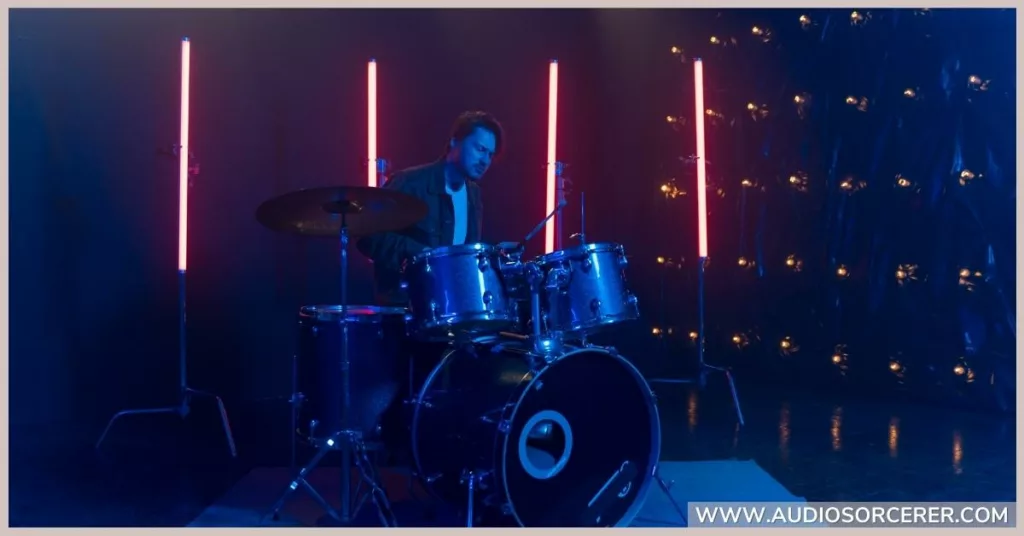
Kick drum mics are the unsung heroes of any great drum recording. They're essential in capturing that booming, rich, low-frequency punch that acts as the heartbeat of a song. Whether you're setting up for a live performance, recording in a professional studio, or laying down tracks in your home setup, the right kick drum mic can make a world of difference in the quality of your sound.
So, let's dive deep into the beat. Our post titled, "Capture The Beat: The Top 5 Best Kick Drum Mics (2024)," will guide you through this year's top contenders in the market. From the punchiest lows to the crispest highs, we're laying out all the specs, pros, cons, and insider's insights to help you choose the right gear. So, prepare to feel the rhythm, power up your drum game and let's find your perfect kick drum mic!
The Shure beta 52A kick drum microphone, manufactured by Shure, weighs 1.35 pounds and has product dimensions of 6.41 x 4.45 x 3.75 inches. It operates on phantom power.
The microphone features a durable construction made of alloy steel, ensuring its resilience. With its XLR connector type, Beta 52A offers a secure and reliable connection to audio interfaces and mixing consoles.
Its tailored frequency response emphasizes low-end frequencies, ranging from 20Hz to 10kHz. Whether you’re after a punchy attack or a thunderous boom, the Beta 52’s dynamic microphone element captures the nuances of the kick drum’s sound.
Its robust metal construction ensures it can handle the knocks and bumps commonly encountered during transport and setups. The mic’s solid build makes it a reliable companion for countless performances.
The microphone’s supercardioid polar pattern minimizes unwanted noise and bleed. Its plug-and-play design and integrated swivel base make it easy to set up and position. This allows beginners to achieve professional-sounding results quickly.
The Shure beta 52A has a reasonable price and is a good entry point into capturing the power and impact of kick drums.
Audix Corporation first manufactured the Audix D6 in April 2011. It’s a dynamic mic that has established itself as a go-to choice for capturing the punchiness of kick drums. It’s compact, measuring 21.5 mm in diameter at the base, 51 mm in diameter at the widest point, and 117 mm in length. It’s also lightweight, weighing 8.03 pounds.
The Audix D6 has a cardioid pickup pattern that isolates the sound source from other noises. This mic works well for modern rock, metal, pop, and many other genres. Its user-friendly design and portability facilitate efficient setups and hassle-free performances.
With its ability to handle high sound pressure levels (SPL) of over 144dB, the D6 captures the impact of low-frequency instruments with remarkable accuracy and clarity. Whether you’re looking for a focused kick drum sound or a clear bass tone, the Audix D6 delivers satisfying results.
The Audix 6 is designed to withstand the demand of professional use, including live performances and studio sessions. The mic's metal body and quality components contribute to its ability to handle the rigors of the road.
The AKG D112 MKII is an updated version of the original AKG D112 mic, incorporating enhancements in its design and performance. It features 55 dB audio sensitivity, capturing the subtleties and power of low-end frequencies with exceptional accuracy.
It measures 4.7 x 5.9 x 2.8 inches and has an XLR connector type, providing a secure connection to audio devices. It first established its presence in the market in March 2015.
Its frequency response emphasizes the punch and clarity of kick drums and bass instruments, allowing them to cut through the mix with precision. The mic’s large diaphragm and low-end sensitivity accurately capture the depth and nuances of low frequencies.
The AKG D112 MKII’s rugged metal housing ensures durability, making it suitable for studio and live performances. The mic can handle high sound pressure levels without distortion or damage.
This mic has an integrated, flexible mount, ensuring a convenient setup. This innovative design allows for easy positioning and attachment to various instruments. This results in saving time and effort in the studio or on stage.
Noise can be a concern when capturing low frequencies, but the AKG D112 MKII addresses this with its integrated hum-compensation coil. This feature effectively reduces electromagnetic interference and hum.
This mic is commonly used for broadcasting, podcasting, and studio recording applications. It’s also used as a kick drum mic because of its low-frequency response and the ability to capture the impact and punch of kick drums.
The compact dimensions of 1 x 1 x 9 inches, make the Electro-Voice RE320 easy to integrate into various recording or live sound setups. This mic balances portability and durability with its weight of 1 pound.
One of the standout features of Electro-Voice RE320 is its Variable-D pattern control. This minimizes positional and off-axis tonal shifts. This results in the mic being able to capture consistent sound even when placed near the kick drum.
The integrated humbucking coil and pop filters contribute to its virtually noiseless performance. It helps to eliminate interference, ensuring clean and professional recordings.
The unique dual-voicing switch of the RE320 adds further flexibility for kick drum miking. You can select from two distinct response curves to tailor the mic’s character to suit your kick drum and musical style.
The Telefunken M82 was first made available in March 2014. It’s a versatile mic weighing 2.5 pounds and with product dimensions of 12.85 x 6.95 x 4.7 inches.
This mic is crafted from brass material and is powered by phantom power. The M82 is equipped with a large diaphragm dynamic cardioid capsule, enabling it to capture sound sources with remarkable precision and fidelity.
The Telefunken M82 provides flexibility and customization options via its switchable low-middle frequency filter and high-frequency boost features.
The switchable low-middle frequency filter allows you to attenuate the lower and middle-frequency range. This can help reduce excessive rumble or muddiness, resulting in a clean kick drum sound.
On the other hand, the high-frequency boost feature allows you to enhance the upper frequency range of the mic’s response. This can be beneficial for adding click to a kick drum and any sound source that needs enhanced high-frequency content.

When it comes to buying a kick drum mic, there are several important factors to consider.
Look for a kick drum mic that can accurately capture the low-frequency content of the kick drum. The mic should strike a balance between attack and warmth. Consider the mic’s frequency response and ability to reproduce the desired tonal characteristics. Some mics are better for certain genres than others.
Kick drum mics are subjected to potential physical impacts. It’s essential to choose a microphone that’s rugged and durable. The mic’s materials and ability to withstand the rigors of live performances or studio recordings determine its build quality.
The cardioid polar pattern captures sound directly from the front and minimizes sound from the sides and rear. This helps minimize bleed from other instruments and ambient noise. Ensure that the mic’s polar pattern suits your needs. You wouldn't use an omni-directional mic for recording kick drum.
Kick drums produce high sound pressure levels. So, the mic should have a high SPL capability to prevent damage or distortion. Check the mic’s specifications to verify whether it can handle the levels typically produced by a kick drum.
Kick drum mics have various mounting options depending on the mic’s design and intended use. Regardless of your chosen mounting style, ensure the mounting mechanism is secure and allows easy mic positioning.
There are various kick drum mics at different price points. Find a kick drum mic that offers the best balance of sound quality, features, and durability within your price range.
Capturing the pulse and power of a kick drum requires the right blend of equipment, technique, and of course, a stellar kick drum mic. Now, armed with the insights and information from this guide, the decision is yours. Choose your microphone, set up your kit, and most importantly, keep that beat going. After all, in the world of music, your kick drum is the heartbeat. So, capture it, enhance it, and let the rhythm lead your journey to creating extraordinary music.
If you found the information in this article helpful, please consider subscribing to our blog for more music production reviews, tips, and advice.
"Some of the links within this article are affiliate links. These links are from various companies such as Amazon. This means if you click on any of these links and purchase the item or service, I will receive an affiliate commission. This is at no cost to you and the money gets invested back into Audio Sorcerer LLC."